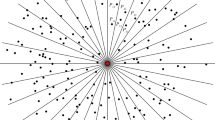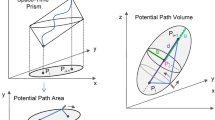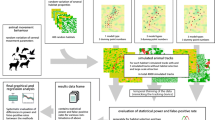Abstract
This paper develops a new method for evaluating the degree of spatial and temporal avoidance in spatial point patterns. We consider point patterns that change over time, where points represent spatial objects that appear at certain locations, stay there for certain periods, and may finally disappear, such as buildings in cities, plants in fields, and birds' nests in forests. Spatial avoidance in this paper refers to the phenomenon that points appear in sparse spaces while points disappear in dense spaces. Spatial avoidance often leads to dispersed point patterns, which are observed in the distributions of drug stores, gas stations, and animal burrows. Temporal avoidance refers to the phenomenon that close points avoid the overlap of their lifetime. Temporal avoidance is found in the relationships between preys and predators, animal species that share the same water resources, and restaurants in shopping malls. The paper develops four measures to evaluate the spatial and temporal patterns of avoidance. Two measures consider the avoidance from a spatial perspective, while the other two focus on the temporal aspect of avoidance. To test the validity of the proposed method, this paper applies it to the analysis of the convenience stores in Shibuya-ku, Tokyo. The results indicated the proposed method's effectiveness and revealed the spatial and temporal patterns of avoidance of convenience stores that existing methods cannot detect.










Similar content being viewed by others
References
Apfelbach R, Blanchard CD, Blanchard RJ, Hayes RA, Mcgregor IS (2005) The effects of predator odors in mammalian prey species: a review of field and laboratory studies. Neurosci Biobehav Rev 29:1123–1144
Baddeley AJ, Turner R (2004) Spatstat: an r package for analyzing spatial point patterns. University of Western Australia, Department of Mathematics and Statistics, Perth, Australia
Baddeley AJ, Møller J, Waagepetersen R (2000) Non- and semi- parametric estimation of interaction in inhomogeneous point patterns. Stat Neerl 54:329–350
Bennison D, Clarke I, Pal J (1995) Locational decision making in retailing: an exploratory framework for analysis. Int Rev Retail Distribution Consumer Res 5:1–20
Bezborodov V, Kondratiev Y, Kutoviy O (2015) Lattice birth-and-death processes. arXiv preprint arXiv:1506.04309
Brodie E Jr, Formanowicz D Jr, Brodie Iii E (1991) Predator avoidance and antipredator mechanisms: distinct pathways to survival. Ethol Ecol Evol 3:73–77
Castro-Arellano I, Lacher Jr TE (2009) Temporal niche segregation in two rodent assemblages of subtropical Mexico. J Trop Ecol 25:593–603
Castrogiovanni GJ, Justis RT, Julian SD (1993) Franchise failure rates: an assessment of magnitude and influencing factors. J Small Bus Manage 31:105
Chiu SN, Stoyan D, Kendall WS, Mecke J (2013) Stochastic geometry and its applications. Wiley, Chichester
Clark PJ, Evans FC (1954) Distance to nearest neighbor as a measure of spatial relationships in populations. Ecology 35:445–453
Comas C, Mateu J (2008) Space–time dependence dynamics for birth–death point processes. Statist Probab Lett 78:2715–2719
Cuzick J, Edwards R (1990) Spatial clustering for inhomogeneous populations. J R Statist Soc Series B (methodol) 52:73–104
Decreusefond L, Flint I, Vergne A (2015) A note on the simulation of the ginibre point process. J Appl Probab 52:1003–1012
Diggle PJ, Chetwynd AG (1991) Second-order analysis of spatial clustering for inhomogeneous populations Biometrics: 47:1155–1163
Diggle PJ, Chetwynd AG, Häggkvist R, Morris SE (1995) Second-order analysis of space-time clustering. Statist Methods Med Res 4:124–136
Dong W, Yang K, Xu Q, Liu L, Chen J (2017) Spatio-temporal pattern analysis for evaluation of the spread of human infections with avian influenza a(h7n9) virus in China, 2013–2014. BMC Infect Dis 17:704
Foster VC, Sarmento P, Sollmann R, Tôrres N, Jácomo AT, Negrões N, Fonseca C, Silveira L (2013) Jaguar and puma activity patterns and predator-prey interactions in four Brazilian biomes. Biotropica 45:373–379
Garcia NL, Kurtz TG (2006) Spatial birth and death processes as solutions of stochastic equations. arXiv preprint math/0605620
Getis A, Franklin J (1987) Second-order neighborhood analysis of mapped point patterns. Ecology 68:473–477
Gooch AM, Petersen SL, Collins GH, Smith TS, Mcmillan BR, Eggett DL (2017) The impact of feral horses on pronghorn behavior at water sources. J Arid Environ 138:38–43
Hall LK, Larsen RT, Knight RN, Mcmillan BR (2018) Feral horses influence both spatial and temporal patterns of water use by native ungulates in a semi-arid environment. Ecosphere 9:e02096
Harmsen BJ, Foster RJ, Silver SC, Ostro LE, Doncaster CP (2009) Spatial and temporal interactions of sympatric jaguars (panthera onca) and pumas (puma concolor) in a neotropical forest. J Mammal 90:612–620
He Z, Tao L, Xie Z, Xu C (2020) Discovering spatial interaction patterns of near repeat crime by spatial association rules mining. Sci Rep 10:17262
Higdon SD, Diggins CA, Cherry MJ, Ford WM (2019) Activity patterns and temporal predator avoidance of white-tailed deer (odocoileus virginianus) during the fawning season. J Ethol 37:283–290
Hollander M, Wolfe DA, Chicken E (2013) Nonparametric statistical methods. Wiley, New Jersey
Jacquez GM (1996) A k-nearest neighbour test for space-time interaction. Statist Med 15:1935–1949
Jensen P (2006) Network-based predictions of retail store commercial categories and optimal locations. Phys Rev E 74:035101
Kirkup M, Rafiq M (1994) Managing tenant mix in new shopping centres. Int J Retail Distrib Manag 22:29–37
Knox E (1964) The detection of space-time interactions. J R Statistical Soc Series C (appl Statist) 13:25–30
Krider RE, Putler DS (2013) Which birds of a feather flock together? clustering and avoidance patterns of similar retail outlets. Geogr Anal 45:123–149
Kulldorff M (1997) A spatial scan statistic. Commun Stat Theory Methods 26:1481–1496
Kulldorff M, Athas WF, Feurer EJ, Miller BA, Key CR (1998) Evaluating cluster alarms: a space-time scan statistic and brain cancer in Los Alamos, New Mexico. Am J Public Health 88:1377–1380
Lang G, Marcon E, Puech F (2020) Distance-based measures of spatial concentration: introducing a relative density function. Ann Reg Sci 64:243–265
Laulajainen R, Gadde L-E (1986) Locational avoidance: a case study of three Swedish retail chains. Reg Stud 20:131–140
Lavancier F, Guével RL (2020) Spatial birth-death-move processes: basic properties and estimation of their intensity functions. arXiv preprint arXiv:2002.05423
Levine N (2004) Crimestat III: a spatial statistics program for the analysis of crime incident locations (version 3.0). Houston (TX): Ned Levine & Associates/Washington, DC: National Institute of Justice
Logan JR, Zhang W, Alba RD (2002) Immigrant enclaves and ethnic communities in New York and Los Angeles. Am Sociol Rev 67:299–322
Lord JD, Wright DB (1981) Competition and location strategy in branch banking: spatial avoidance or clustering. Urban Geogr 2:189–200
Lotwick H, Silverman B (1981) Convergence of spatial birth-and-death processes Mathematical Proceedings of the Cambridge Philosophical Society Cambridge University Press
Lynam AJ, Jenks KE, Tantipisanuh N, Chutipong W, Ngoprasert D, Gale GA, Steinmetz R, Sukmasuang R, Bhumpakphan N, Grassman Jr LI (2013) Terrestrial activity patterns of wild cats from camera-trapping. Raffles Bull Zool 61:407–415
Mantel N (1967) The detection of disease clustering and a generalized regression approach. Can Res 27:209–220
Marcon E, Puech F (2017) A typology of distance-based measures of spatial concentration. Reg Sci Urban Econ 62:56–67
Matérn B (1960) Stochastic models and their application to some problems in forest surveys and other sampling investigations Medd Statens Skogsforskningsinstitut 49
Miyoshi N, Shirai T (2014) A cellular network model with ginibre configured base stations. Adv Appl Probab 46:832–845
Moller J, Waagepetersen RP (2003) Statistical inference and simulation for spatial point processes. CRC Press, Boca Raton, FL
Muller C, Woods RH (1991) The real failure rate of restaurants. Hospitality Rev 9:7
Netz JS, Taylor BA (2002) Maximum or minimum differentiation? location patterns of retail outlets. Rev Econ Statist 84:162–175
Okabe A, Yamada I (2001) The K-function method on a network and its computational implementation. Geogr Anal 33:271–290
Oppewal H, Holyoake B (2004) Bundling and retail agglomeration effects on shopping behavior. J Retail Consum Serv 11:61–74
Parsa H, Self JT, Njite D, King T (2005) Why restaurants fail. Cornell Hotel and Restaurant Administration Quarterly 46:304–322
Phillips DL, Macmahon JA (1981) Competition and spacing patterns in desert shrubs J Ecol 69:97–115
Philo C, Philo P (2021) 2.15 or not 2.15? an historical-analytical inquiry into the nearest-neighbor statistic. Geogr Anal. https://onlinelibrary.wiley.com/doi/full/10.1111/gean.12284
Planque R, Slabbekoorn H (2008) Spectral overlap in songs and temporal avoidance in a peruvian bird assemblage. Ethology 114:262–271
Preston C (1975) Spatial birth-and-death processes. Bulletin Int Statist Inst 46:371–391
Ripley BD (1976) The second-order analysis of stationary point processes. J Appl Probab 13:255–266
San Jose JJ, Farinas MR, Rosales J (1991) Spatial patterns of trees and structuring factors in a trachypogon savanna of the orinoco llanos. Biotropica 23:114–123
Shapiro M, Schein S, De Monasterio F (1985) Regularity and structure of the spatial pattern of blue cones of macaque retina. J Am Stat Assoc 80:803–812
Sprent P, Smeeton NC (2016) Applied nonparametric statistical methods. CRC Press, Boca Raton, FL
Stewart MC, Austin D, Bourne G (1993) Habitat structure and the dispersion of gopher tortoises on a nature preserve. Florida Scientist 56:70–81
Strauss D (1975) A model for clustering. Biometrika 62:467–475
Stromberg MR (1978) Subsurface burrow connections and entrance spatial pattern of prairie dogs. Southwest Nat 23:173–180
Suzuki R, Taylor CE, Cody ML (2012) Soundspace partitioning to increase communication efficiency in bird communities. Artif Life Robot 17:30–34
Teller C, Reutterer T (2008) The evolving concept of retail attractiveness: what makes retail agglomerations attractive when customers shop at them? J Retail Consum Serv 15:127–143
Turner AM, Montgomery SL (2003) Spatial and temporal scales of predator avoidance: experiments with fish and snails. Ecology 84:616–622
Turner LM, Wessel T (2013) Upwards, outwards and westwards: relocation of ethnic minority groups in the oslo region. Geografiska Annaler Series b, Human Geogr 95:1–16
Wald A, Wolfowitz J (1940) On a test whether two samples are from the same population. Ann Math Statist 11:147–162
Wang F, Chen C, Xiu C, Zhang P (2014) Location analysis of retail stores in Changchun, China: a street centrality perspective. Cities 41:54–63
Wiegand T, Moloney KA (2013) Handbook of spatial point-pattern analysis in ecology. CRC Press, Boca Raton, FL
Yang X-J, Slabbekoorn H (2014) Timing vocal behavior: lack of temporal overlap avoidance to fluctuating noise levels in singing eurasian wrens. Behav Proc 108:131–137
Yiu CY, Xu SY (2012) A tenant-mix model for shopping malls. Eur J Mark 46:524–541
Zhou Y, Zhang Q, Yu H (2018) Server deployment planning and performance analysis in mobile edge computing with β-ginibre point process 2018 IEEE/CIC International Conference on Communications in China (ICCC) Beijing, China
Acknowledgements
This research was supported by JSPS KAKENHI.
Funding
Japan Society for the Promotion of Science, 16H01830, Yukio Sadahiro, 18K18535, Yukio Sadahiro, 19H02375, Yukio Sadahiro
Author information
Authors and Affiliations
Corresponding author
Additional information
Publisher's Note
Springer Nature remains neutral with regard to jurisdictional claims in published maps and institutional affiliations.
Appendix
Appendix
This appendix describes the mathematical definition of the four statistics used in the paper. We hope this will help the computational implementation of the proposed method.
We first consider dA, i.e., the average distance to the nearest point when points appear. Let τ(t1, t2) be a binary variable that evaluates the order of two time points t1 and t2:
Using the function, we can evaluate whether Pi exists at time t:
It is one if Pi exists at time t while it is zero if Pi does not exist.
The distance to the nearest point when Pi appears is mathematically given by
where
The denominator of Eq. (6) is 1 + ε if Pj exists when Pi appears at time TiA, while it is ε if Pj does not exist. We added ε to avoid dividing ||zj-zi|| by pj(TiA) = 0 when if Pj does not exist. Since ε is very small, ||zj-zi||/ε is very large for the points that do not exist when Pi appears. The minimum value of ||zj-zi||/pj(TiA) + ε is chosen only from the points that exist when Pi appears. The minimum value divided by 1 + ε is finally multiplied by 1 + ε, and consequently, Eq. (6) gives the distance to the nearest point.
The number of appearances in C⊗Ω is mathematically given by
where σ(Pi, C) is a binary variable that indicates whether Pi is contained in C:
The term τ(T1, TiA) τ(TiA, T2) is one if Pi appears between T1 and T2, and thus nA indicates the number of appearances in C⊗Ω. Using diA, we can calculate the average distance to the nearest point when points appear:
where the numerator is the summation of the distance to the nearest point when points appear.
The statistic dD, i.e., the average distance to the nearest point when points disappear, is calculated as follows. The distance to the nearest point when Pi disappears is given by
The statistic dD is
where nD is given by
The calculation of ν is as follows. The expected number of points at time t in C under the random process R2 is given by
where n(t) is the number of points at time t:
We evaluate the fluctuation in the number of points by the average variance over the time period Ω:
We finally consider the calculation of η. The number of appearances between the appearance of Pi and the disappearance of Pj is given by
The term τ(TiA, TkA) τ(TkA, TjD) + τ(TjD, TkA) τ(TkA, TiA) is one if Pi appears between TiA and TjD. Consequently, KijA indicates the number of appearances between the appearance of Pi and the disappearance of Pj. The number of disappearances is
The number of the sequences of appearances and disappearances is
where
Rights and permissions
About this article
Cite this article
Sadahiro, Y. A method for evaluating the degree of spatial and temporal avoidance in spatial point patterns. J Geogr Syst 24, 241–260 (2022). https://doi.org/10.1007/s10109-022-00373-x
Received:
Accepted:
Published:
Issue Date:
DOI: https://doi.org/10.1007/s10109-022-00373-x




